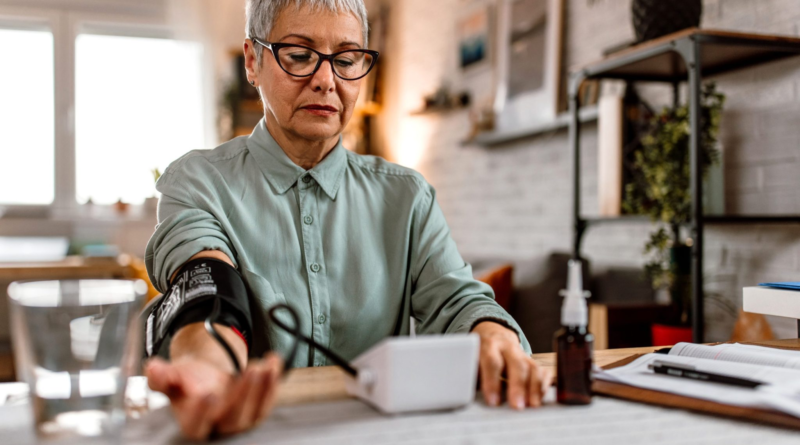Hypertension is a ‘silent killer.’ Here’s what your blood pressure should be at every age
Can you recall a doctor’s appointment during which your blood pressure wasn’t taken? Probably not. It’s a vital sign—along with heart rate, breathing rate, and body temperature—that reflects how well your body is functioning. But unless you’ve already been diagnosed with high blood pressure or another medical condition that requires you to monitor it at home, chances are you don’t often take your own blood pressure.
“Most people, the only time they get it checked is when they’re at the doctor’s office,” Dr. Joseph Ebinger, director of the coronary intensive care unit at the Smidt Heart Institute at Cedars-Sinai Medical Center in Los Angeles, tells Fortune. “Individuals, if they have their own history of having high blood pressure measurement, or a strong family history of high blood pressure, or, finally, cardiovascular risk factors—things like diabetes or peripheral arterial disease—I would recommend that they have a blood pressure cuff at home.”
Whereas your heart rate is the number of times your heart beats per minute, your blood pressure measures the force with which your blood circulates and stresses your artery walls. If you have high blood pressure, also called hypertension, your heart has to work harder than normal to pump blood throughout your body. Over time, hypertension can lead to serious medical problems including stroke, heart attack, and kidney failure.
Despite the dangers of hypertension, its lack of symptoms means people may not know they have the condition until the damage has been done. That’s why high blood pressure is a “silent killer.” Half of U.S. adults have hypertension, according to the National Heart, Lung, and Blood Institute (NHLBI), but only two-thirds of them know it.
“It’s the No. 1 most common cardiovascular risk factor in the country,” Ebinger says. “Finding ways to control it is really important in minimizing your risk, and it can happen early on in life.
“We know that individuals who are at increased risk for developing [hypertension] later in life tend to have higher-than-normal blood pressures in their midlife—even in their 30s—and so regular screening and monitoring of your blood pressure is key.”
What’s the difference between systolic and diastolic blood pressure?
You’ve likely heard your health care provider say your blood pressure is something like “120 over 80,” typically a larger number over a smaller number. Together, the two are measured in millimeters of mercury, written as 120/80 mm Hg. Dr. Gregory Katz, a cardiologist at NYU Langone Health, explains the difference.
“Blood pressure is the pressure that your arteries are experiencing during the entirety of your life, and that’s going to differ when your heart is contracting versus when your heart is relaxing,” Katz tells Fortune. “That first number of blood pressure is called the systolic number. That’s the pressure in your arteries when your heart is ejecting blood into them, and then the bottom number is called the diastolic pressure, which is the pressure in your arteries when your heart is relaxed.”
Katz adds, “The overall pressure, which is going to be an average of both the systolic and the diastolic, that’s going to be adjusted based on the fact that your heart is more often relaxing than contracting. It’s called the mean arterial pressure (MAP).”
The American Heart Association (AHA) considers a systolic pressure below 120 and a diastolic pressure below 80 to be normal for adults. Hypertension is classified into stages of severity; stage 1 has a systolic reading of 130 to 139 or a diastolic reading of 80 to 89. A systolic measurement above 180 and/or a diastolic measurement above 120 constitutes a hypertensive crisis requiring emergency medical care.
Hypertensive emergencies aside, remember that your blood pressure practically changes minute to minute, Katz says, so don’t let a single abnormal reading alarm you.
“Any type of physical activity raises your blood pressure. Exercise, you’re supposed to have a normal blood pressure elevation when you are exerting yourself,” Katz tells Fortune. “Changing the position that you’re in, going from sitting to standing, will change your blood pressure; being stressed out will change your blood pressure; rushing will change your blood pressure. There are a million different things that are going to have an impact on what your blood pressure is.”
If your blood pressure is regularly high when you’re at rest and ease, however, ask your doctor about being tested for hypertension.
Who’s at risk of high blood pressure?
According to the Cleveland Clinic, you’re at risk of high blood pressure if you:
- Are 60+
- Are Black
- Don’t exercise
- Eat foods high in salt
- Have diabetes
- Have a family history of hypertension, diabetes, or cardiovascular disease
- Have high cholesterol
- Have obesity
- Use oral contraceptives
- Use tobacco products
Alcohol use is also a risk factor, per the Centers for Disease Control and Prevention. The agency advises women and men to not have more than one or two drinks a day, respectively.
Does blood pressure increase with age?
Children and teens can have high blood pressure too. As with adults, blood pressure below 120/80 is normal for teens. For those 12 and younger, a reading below the 90th percentile of their peers is ideal, according to the American Academy of Pediatrics. A pediatrician can determine if your child has or is at risk of developing hypertension.
As of 2017, the AHA no longer defines hypertension differently for adults younger than 65 and those 65 and older. (Previously, the hypertension threshold was 140/90 for younger adults and 150/80 for older adults.) Still, most people experience a rise in blood pressure as they get older, Katz says.
“I think a lot of that is related to the arteries getting stiffer, just like everything else gets stiffer as we get older,” Katz says. “The way that our arteries are going to have different levels of stiffness versus elasticity, it’s going to be partly reflective of what is our lifestyle like, and how much physical activity are we doing.”
Katz adds, “I generally tell patients, ‘You probably need more physical activity as you get older to prevent your blood pressure from going up.’ And, unfortunately, most people do less physical activity as they get older.”

SCIENCE PHOTO LIBRARY/Getty Images
Ways to lower blood pressure
Depending on your medical history and the severity of your hypertension, your doctor may prescribe medication to help lower your blood pressure. But your behavior can also help keep your hypertension under control.
“There are big lifestyle factors that can be done; diet and exercise are key to this,” Ebinger says. “Cardiovascular exercise regularly, at least 150 minutes a week. And from a diet perspective, minimizing alcohol intake and, in particular, avoiding salt, which is a way that drives blood pressure up.”
In addition, the NHLBI recommends:
How to take your own blood pressure
You don’t need to have stage 2 hypertension or be on the verge of a hypertensive crisis to have high blood pressure negatively impact your health, explains Dr. Luke Laffin, co-director of Cleveland Clinic’s Center for Blood Pressure Disorders.
“Most people have no idea their blood pressure is elevated or uncontrolled; they do not have symptoms,” Laffin tells Fortune via email. “However, we know that even small chronic increases in blood pressure increase one’s risk for stroke, heart attack, heart failure, and kidney disease.”
Keeping tabs on your blood pressure may be more convenient than you think. Relatively inexpensive monitors are widely available, and some smartwatches and fitness trackers have blood pressure monitoring capabilities. However, the AHA cautions against wrist and finger monitors, which it says aren’t as reliable as traditional bicep cuff monitors. Visit ValidateBP.org to see if your device has been validated by the American Medical Association.
“If someone does not have a blood pressure machine at home, they should have their blood pressure checked when they see their primary care doctor and, if elevated, talk about how they could also monitor at home,” Laffin says.
Follow these AHA steps to get the most accurate blood pressure reading possible at home:
- Plan ahead. Don’t smoke, drink caffeinated beverages, or exercise within 30 minutes before taking your blood pressure. Empty your bladder.
- Don’t take the measurement over clothes. Remove the clothing over the arm that will be used to measure blood pressure.
- You can use either arm. Usually there is not a big difference between readings on them.
- Be still. Allow at least five minutes of quiet rest before measurements. Don’t talk or use the phone.
- Sit correctly. Sit with your back straight and supported (on a dining chair, rather than a sofa). Your feet should be flat on the floor. Do not cross your legs. Support your arm on a flat surface. The middle of the cuff should be placed on the upper arm at heart level. Check your monitor’s instructions for an illustration or have your health care professional show you how.
- Measure at the same time every day. Take the readings at the same time each day. Talk with your health care professional about how often to take your blood pressure.
- Take multiple readings and record the results. Each time you measure, take two readings one minute apart. Record the results using a printable (PDF) tracker. If your monitor has built-in memory to store your readings, take it with you to your medical appointments. Some monitors may also let you upload your readings to a secure website.
For more on heart health:



